Abstract
Human–machine interfaces based on force touch panels have attracted enormous attention due to the merits of the high human–machine interaction efficiency. Many studies have been devoted to diverse force touch technologies. Broad applications in terms of both actual use and research have been developed, such as 3D touch and force-based keystroke authentication. The fruitful results are based on the assumption that users’ touch habits remain unchanged over time; thus, a stationary customized force-sensing model can be built. However, for long-term use, users’ touch habits change due to time-drifting and specific events, causing a decrease in the performance of stationary force-sensing models. To address this issue, a rectified artificial neural network for long-term force sensing in piezoelectric touch panels is presented in this paper. With additional information on the touching time and the occurrence of specific events, the force level predictions were rectified, achieving an accuracy of 97.62% for a long-term data set. The proposed technique enables customized force sensing for long-term use and enhances the human–machine interactive efficiency.
1. Introduction
With the great development of touchscreen technologies, touch panels (TPs) have been wildly used for human–machine interactions in many electronic devices, especially for smartphones, which have become an indispensable part of our daily life [1]. Of the numerous existing touch panel techniques, touch panels with traditional capacitive- and resistive-based architectures dominate the market; however, they can only locate the 2D (x-y axis) position. In 2015, Apple Inc. applied 3D (force) touch detection in its commercial product, the iPhone 6S, which gained enormous attention from the market for the obtained additional force information [2]. Three-dimensional touch detection enables the interaction of additional touch force information, thereby enhancing the human–machine interaction efficiency and allowing for promising prospects, such as gaming with the force-sensing engine. Due to the huge development potential and broad market prospect of 3D touch detection, a lot of research has been conducted by various researchers and companies [3,4,5,6,7,8]. Within this area, piezoelectric sensors in TPs are attracting significant attention because of their high force detection sensitivity, simple panel structure, convenient readout circuitry, and low power consumption [3].
Because of the properties of piezoelectric materials and the distinct biological characteristics of different users, the same force of touch with different states (such as the touch location, touch angle, touch speed, and specific user) could induce a totally different voltage response, resulting in an unfavorable force-sensing accuracy [9,10]. The solution to this problem is the use of an artificial neural network (ANN) customized for each specific user, which can analyze the response voltage from different locations on a piezoelectric touch panel with an accuracy of 93.3% [9]. A higher accuracy of 97% can be achieved by adjusting the hyperparameters of the ANN [11]. To solve the data-hungry problem caused by the ANN, which limits practical applications, an ensemble learning-based technique was utilized to achieve a higher accuracy of 98.32% while collecting much less data [10].
Despite the solution of customizing the force-sensing model, prediction errors still occur mostly in the following situations. First, the touch habit of a user is dynamic, which means that it shifts over time. The specialized force-sensing model is based on the assumption that the touch habits of a user remain unchanged over time. Therefore, the static force-sensing model will deviate from the correct prediction more and more as time goes on. Second, the force exertion of touch is altered after certain events, such as tiring exercise. The original force-sensing network will probably generate an unanticipated answer without prior information, negatively affecting the user’s experience. Time-shifting and specific events are the main two factors limiting the long-term use of piezoelectric touch panels in real life. To tackle these problems, a rectified artificial neural network for long-term force sensing in piezoelectric panels was proposed and implemented in this paper. The conceptual paradigm of the rectified artificial neural network is shown in Figure 1. Here, a traditional ANN was established first to learn the relationship between the force-induced voltage and the force level output. By adding information on the touching time and the occurrence of specific events, the rectified artificial neural network can map the additional input information to the variation in the force level output. When used in this way, the force-sensing network performs better in long-term situations that include time-shifting and specific event problems. Compared to the normal static method without rectification, the proposed technique performed excellently, with an accuracy of 94.1% for a long-term data set, 6% higher than the ordinary method. This shows the practicability of customized force sensing in long-term situations.
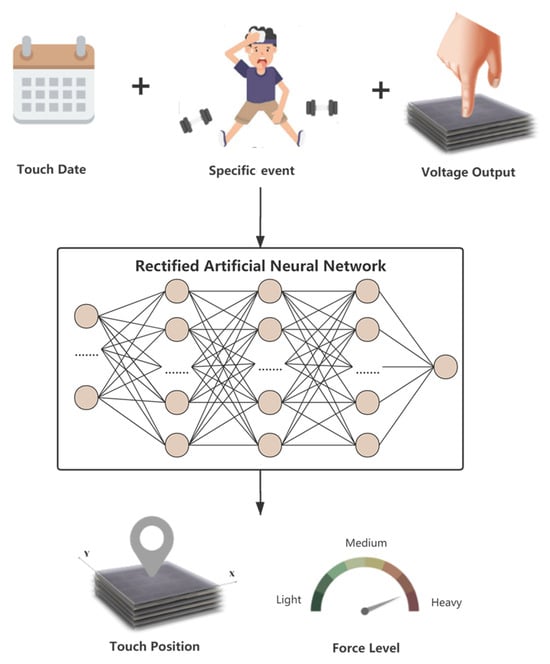
Figure 1.
The conceptual paradigm of the rectified artificial neural network technique for long-term force sensing.
The rest of this paper is organized as follows: Section 2 briefly reviews state-of-the-art works on force sensing in piezoelectric touch panels. Section 3 describes the architecture and work principle of the touch panel used in this experiment. The methodology of the rectified ANN used to solve the time-shifting and specific event problems is explicitly explained in Section 4. The results and discussion are given in Section 5. And the conclusion is drawn in Section 6.
2. Literature Review
2.1. Working Principle of Piezoelectric Touch Panel
The non-centrosymmetric structures of piezoelectric materials result in generated charges with applied mechanical stress [12]. There is a linear relationship between the force-induced polarization of the piezoelectric film and the applied stress, according to the following equations:
where is the induced polarization, is the applied stress, and is the piezoelectric coefficient. The generated surface charge can be expressed as follows:
where is the contact area. Thus, the induced voltage is proportional to the applied force amplitude, expressed as follows:
where t is the thickness of the piezoelectric film, is the vacuum permittivity, and is the relative permittivity of the piezoelectric material [13]. Broadly utilized piezoelectric materials include polyvinylidene difluoride (PVDF) [14], quartz [15], and Piezopaint [11].
2.2. Challenges in Force Detection
Although piezoelectric materials have merits, such as a high sensitivity, a low power consumption, and a simple relationship between the applied stress and the induced voltage, commercialized piezoelectric touch panels have not been widely accepted in the market because of their unfavorable force detection accuracy, which is caused by two things.
The first is the unstable force–voltage responsivity caused by the properties of the touch panel itself. Based on the thin plate structure of the touch panel, any change in the panel geometry or mechanical properties results in an inaccurate force interpretation, indicating that the same force amplitude can induce different normal stresses at different touch locations. Furthermore, the touch stress at one location can be propagated to an adjacent area. All of these undesired factors lead to an unstable force–voltage responsivity, reducing the force detection accuracy [16]. The second is the personalized force definition induced by users. When given the task of lightly touching a touch panel, different users will make various touch actions based on their own definition of the force level and their touch habits (such as the touch angle and contact position).
The unstable force–voltage responsivity and personalized force definitions are the two factors that limit the successful use of piezoelectric touch panels in commercial interactive displays.
2.3. State-of-the-Art Solution
The current solution is to use an ANN to map the input space of the voltages to the output space of the touch force level. Previous research [9] utilized an ANN technique to personalized force sensing in a piezoelectric touch panel. By feeding a large amount of labeled data to the ANN, it learned the underlying information about mapping from the input voltage to the output force level, and by considering the unstable force–voltage responsivity and personalized force definitions, it reached an accuracy of 93.3% [9]. While the ANN performed well for personalized force sensing in a piezoelectric touch panel, a great demand in terms of data, which would be borne by the users, limits the practical usage of the ANN method. To solve the high-volume user input issue, an ensemble learning-based technique was developed [10] to decrease the amount of data collected from the user while retaining a high accuracy of 98.32%.
However, the static ANN force-sensing model does not work well for long-term use. In real application scenarios, the touch habits of a user gradually vary over time, causing the static model’s predictions to deviate more and more as time goes on. And after a specific event such as exercise, the force touch pattern differs a great deal due to joint and muscle fatigue. By taking time-shifting and specific event factors into consideration, a rectified model that can compensate for the force detection drift caused by these factors is urgently needed. Until then, a fairly stable implementation and the substantial real-world usage of piezoelectric touch panels cannot be realized.
Hence, in this article, a rectified artificial neural network method for long-term force sensing was implemented. The details are explained in the following sections.
3. Piezoelectric Touch Panel System
To implement the method of rectified artificial neural networks for long-term force sensing, a five-layer piezoelectric touch panel was constructed by following a conventional sandwich architecture (Figure 2a), where the polyvinylidene difluoride (PVDF) [14] piezoelectric layer was sandwiched between patterned top electrodes and a continuous ground layer, protected by outer PET films. While this simplified architecture prioritizes force signal acquisition for algorithm validation, we note that industrial designs often employ hybrid capacitive–piezoelectric stacks to simultaneously improve the positional and force-sensing accuracy. The selection of PVDF over ceramic piezoelectric materials stems from its superior mechanical flexibility and optical transparency, despite having lower dielectric constants, as brittle ceramics are impractical for large-area panels. To mitigate the positional uncertainty inherent in pure piezoelectric configurations, the current prototype confined force sensing to nine pre-mapped regions (Figure 2b) rather than full-panel detection. The 4 × 4 top electrode matrix generates analog signals through PVDF deformation. This constrained-area approach balances experimental repeatability with system complexity.

Figure 2.
(a) Structure of the touch panel. (b) Geometry of the touch panel and its photograph.
A block diagram of the piezoelectric touch panel system is shown in Figure 3. The piezoelectric touch panel can be modeled as a charge generator with an equivalent circuit comprising a capacitor and a resistor, where the generated charge amplitude depends on the applied force and the piezoelectric properties of the PVDF layer. To convert the force-induced charges into a measurable voltage signal, a charge amplifier circuit was implemented to interface with the PVDF sensor. The output voltage of this circuit is governed by the relationship Vout = −Q/CF, where Q represents the generated charge and CF is the feedback capacitance. The time constant t = RfCf and cutoff frequency fcutoff = 1/(2πRfCf) critically influence the signal bandwidth and low-frequency response of the system. To maintain sensitivity to the low-frequency force variations that are characteristic of touch interactions, a high feedback resistance Rf was employed, which reduced the cutoff frequency while amplifying the signal. The amplified analog voltage was then routed through a voltage follower to ensure impedance matching with the Arduino Mega 2560 ADC, preserving the signal fidelity. After analog-to-digital conversion, the digitized voltage signals were transmitted to a computer for processing via the rectified artificial neural network algorithm, which compensated for nonlinearities in the piezoelectric output and enhanced the long-term force-tracking accuracy.
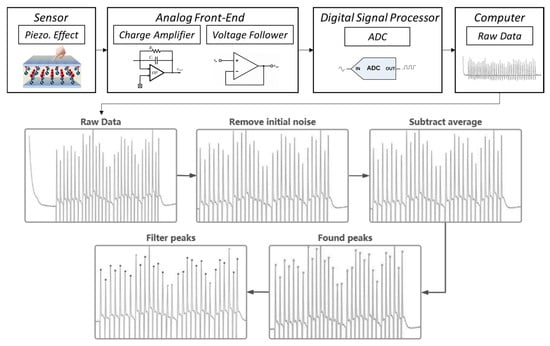
Figure 3.
Block diagram of piezoelectric touch panel system.
4. Methodology
In order to establish a force-sensing network that functions well for long-term use, a rectified artificial neural network method was proposed, in which the time at which a touch event occurs and the occurrence of specific events are recorded as well as the voltage output of nine channels. This additional information is comprehensively utilized by the force-sensing network to provide a more accurate result. As explained in [9,10], three force levels (light, medium, and heavy) were employed in this experiment for the limited discrimination of the force levels of most users. The methodology of the rectified artificial neural network involves three steps:
- Collecting touch data that comprise the voltage outputs of nine channels, the time at which force touch events occur, and the occurrence of specific events;
- Pre-processing the data;
- Training the rectified artificial neural network.
The flowchart of the rectified artificial neural network is shown in Figure 4. The detailed explanations of the above three steps are given in the rest of the section.
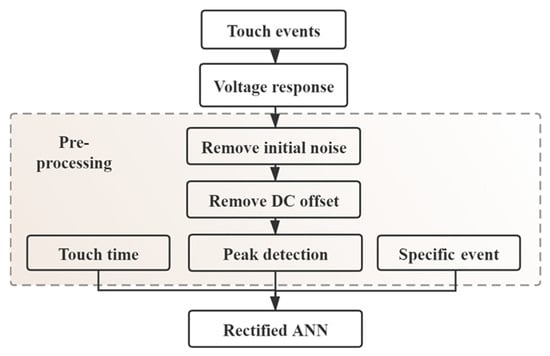
Figure 4.
The flowchart of the rectified ANN method.
4.1. Data Collection
For the force classification task, three force levels (light, medium, and heavy) of touch are required for the user. A force touch event is defined as the user touching one of nine areas in the touch panel using one of three force levels. Corresponding to each force touch event are the voltage outputs of the nine channels, the time at which the touch event occurred, and the occurrence of specific events. Here, in this experiment, exercise (specifically, push-ups) was considered as the specific event. Hence, the occurrence of a specific event specifies whether the force touch event occurred before or after performing push-ups. The data collection was conducted over a month for each participant. By varying the four factors (touch area: 1–9; touch force: light, medium, or heavy; time: Day 1 to Day 30; and occurrence of specific event: after push-ups or not) that affected the voltage outputs, a combination of 9 × 3 × 30 × 2 was computed, resulting in a total of 1620 different kinds of force touch events.
With 30 repetitions of each kind of force touch event, 48,600 touch data points were gathered. For each touch event, all the voltage outputs of the nine channels were required for further processing because of the stress propagation and boundary conditions of the touch panel.
4.2. Data Pre-Processing
The voltage outputs of the nine channels together with the time and the occurrence of specific events could not be directly fed to the rectified artificial neural network until the data were pre-processed. First, initial noise was generated at every beginning stage of a data acquisition process, caused by the startup of the Arduino Mega 2560 board. Voltages in the first 40 ms were eliminated to avoid the detection of a fake force touch event comprising this initial noise. Second, to remove the voltage offsets of each channel, the mean voltage of each channel during the time without touching was subtracted. During a force touch event, pressing and releasing the touch panel corresponded to the peak and valley in the voltage signals. The peak values of the voltage output were utilized to represent the force amplitude of pressing. A peak searching algorithm [12] was applied to the pre-processed voltage data to find the peak value representing the force touch event. Note that the peak values of the nine channels may not appear at the same time. The channel with the highest peak value was considered the dominant channel. The peak values of the other channels were determined by the peak time of the dominant channel instead of the peak searching algorithm. To ensure signal validity, any peaks exceeding the expected operational range (e.g., due to transient spikes or hardware artifacts) were automatically filtered out. These outliers were discarded because they may have resulted from electrical interference, sensor saturation, or unintended mechanical disturbances rather than genuine touch inputs. The peak values of the nine channels together with the time and the occurrence of specific events formed an 11 × 1 vector representing a complete touch event. All the 48,600 touch events (calculated previously) formed an 11 × 48,600 vector, which was used as the ANN input. In addition, a 2 × 48,600 vector indicting the ground truth of the touch location and force level was fed to the ANN as labels.
4.3. Rectified ANN Construction
The network structure of the rectified artificial neural network is shown in Figure 5, consisting of two five-layer neural networks. The first network used the 11 × vector as the input, which contained the information of the peak values of the nine channels, the touch time, and the occurrence of specific events. The ground truths of the touch position were fed as labels. The output of the first network was the prediction of the touch position. The prediction of the touch position together with the 11 × vector was sent to the second network as the inputs, while the ground truths of the force level were fed as labels. The outputs were the classification results of the three force levels. The processed 11 × 48,600 vector was shuffled and normalized [17]; 80% of it was used for the training data set, and the rest was used for the testing data set. The categorical cross-entropy loss function was selected for optimizing the rectified ANN model. Adam was selected for the stochastic gradient descent for the merit of a high efficiency [18,19]. The ‘ReLU’ activation function was used for the input and hidden layers for its low time consumption [20,21,22]. To reduce over-fitting, a dropout was used on both the input layer and hidden layer, with a dropout rate of 0.15 [23]. Taking into account the training speed and overall performance, a batch size of 128 and a training epoch number of 500 were selected empirically [24]. More detailed parameter settings are shown in Table 1.
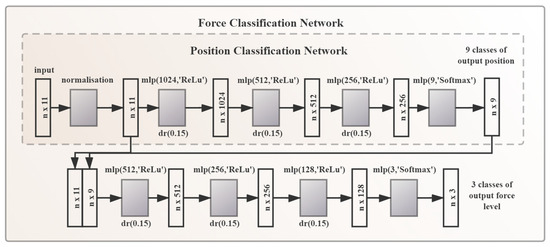
Figure 5.
The network structure of the rectified ANN.

Table 1.
The hyperparameters of the position classification network of the force classification network.
5. Results and Discussion
This section mainly consists of the following parts: a comparison of the results using traditional ANN and rectified ANN techniques; the visualization of the results and the impact of time-shifting and specific event factors; the parameter settings of the rectified ANN; the computational time cost; and a comparison with related works.
5.1. Comparison of Results Using Traditional ANN and Rectified ANN
To validate the performance of the rectified ANN technique, four comparative experiments were conducted: traditional ANN, rectified ANN using only the date information, rectified ANN using only the specific event information, and rectified ANN using both the date and specific event information. As shown in Figure 6, the accuracy of the force level classification using the traditional ANN was 88.19%. After adding the date or specific event information, the accuracy of the force level classification rose to 92.01% and 88.77%, respectively. When considering the above two factors together, the accuracy reached 92.71%.
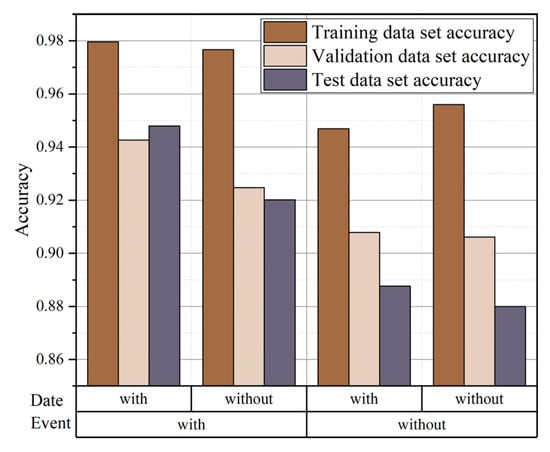
Figure 6.
Comparison of results using traditional ANN and rectified ANN.
Without prior information, the traditional ANN made unfavorable predictions due to the time-shifting and specific event factors. The rectified ANN compensated for the impact of the above two factors, making better predictions of the force level classification from long-term data sets. As shown in Figure 6, the rectified ANN that only considered the time-shifting factor performed slightly better than the one that only considered the specific event factor, indicating that the time-shifting factor has a greater impact on the force classification result.
5.2. Visualization of Experimental Result
In this section, the impact of time-shifting and specific events on force estimation are visualized, as shown in Figure 7.
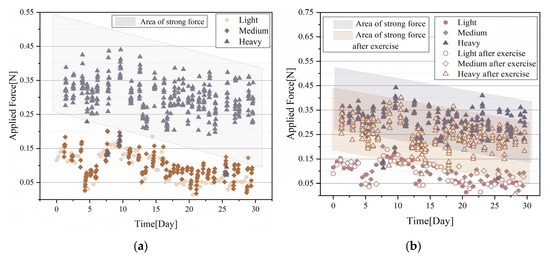
Figure 7.
(a) Displacement of applied force with the impact of time-shifting; (b) displacement of applied force with the impact of a specific event.
In Figure 7a, it can be observed that the heavy force strength on Position 1 was gradually altered over a month. This was caused by the time-shifting factor, which considers the fact that a user’s touch habitat is rather dynamic during long-term use. An experiment conducted over months or even years may have more interesting results. As Figure 7b shows, the heavy force amplitude after performing push-ups decreased, which was caused by fatigue after the exercise. In addition to exercise, specific events could include waking up, lying down, etc. With additional information that can affect the force of the touch on the touch panel, the predictions of the rectified ANN were more precise.
5.3. Parameter Settings of Rectified ANN
To select the best hyperparameters for the rectified ANN, a series of parameter setting adjustments were carried out, as shown in Figure 8. For the overall performance, the experimental results with different batch sizes are shown in Figure 8a. With an increase in the batch size, the accuracy of the force classification reached a maximum at the batch sizes of 64 and 128, after which the performance began to decline. In Figure 8b, the training time cost decreased significantly with an increase in the batch size. In general, a small batch size would introduce noise to the state variable to skip the sharp minima; however, this would also raise the time cost in the training process. Alternatively, a big batch size could avoid gradient oscillation, but possibly result in a constant gradient direction. Considering the overall performance and time cost, a batch size of 128 was selected.
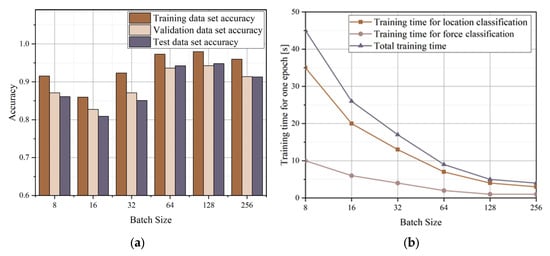
Figure 8.
(a) Classification accuracy of rectified ANNs using different batch sizes; (b) training time cost of rectified ANNs using different batch sizes.
5.4. Computational Time Cost
The computational time cost consisted of the model training time and the force estimation time cost. All of the training processes were performed on a 2.5 GHz Intel® Core™ i5-7300 HQ CPU (Intel Corporation, 2200 Mission College Blvd, Santa Clara, CA 95054, USA) via the Anaconda Python software (version 2020.17). The data pre-processing time, rectified ANN model training time, and force estimation time were 61 s, 220 s, and 1 ms, respectively. For practical use, such as force touch detection in smartphones, the long-term data sets would be collected in real time, with the additional information provided by the clock and motion sensors on smartphones. The rectified ANN model could be trained dynamically online. The classification time cost occurs for each touch event. The prediction of the force level can be completed on the millisecond level; thus, the time delay of the methodology is acceptable and feasible.
5.5. Comparison of Related Works
Our proposed rectified ANN addresses a critical gap in long-term force sensing for piezoelectric touch panels. As shown in Table 2, while the existing methods can achieve a high accuracy in controlled settings (e.g., 97–98.32% in [10,16]), they assume static user habits and do not account for temporal drift or physiological changes (e.g., post-exercise fatigue). By integrating time- and event-specific inputs (e.g., exercise markers), our method achieved a 97.62% accuracy in dynamic scenarios, which is 10% higher than traditional ANNs for long-term data sets (Section 5.1). Notably, this method retains the efficiency advantages of ensemble learning [10], requiring under 1 min of initial user-specific data. The computational cost (220 s training, 1 ms inference) ensures real-time feasibility, and the integration of sensor-derived temporal/contextual data (e.g., motion sensors in smartphones) minimizes user intervention. This makes the rectified ANN a robust solution for practical, long-term HMI applications where user behavior evolves over time.

Table 2.
Comparative analysis of force-sensing methods for piezoelectric touch panels.
6. Conclusions
A rectified artificial neural network technique was addressed for long-term force sensing in piezoelectric force touch panels. The experimental results demonstrate that a high force detection accuracy of 97.62% can be obtained when considering both time-shifting and specific event factors, which is 10% higher than the traditional technique. This technique results in a high force touch detection accuracy for long-term use in touch panel applications, such as in smartphones, with the additional information autonomously collected by other sensors, enhancing the user experiences of human–machine interfaces.
Author Contributions
Conceptualization, Y.L. and S.G.; methodology, S.G.; software, Y.L.; validation, Y.L., S.G. and X.L.; formal analysis, Y.L.; investigation, W.M.; resources, H.M.; data curation, X.L.; writing—original draft preparation, Y.L.; writing—review and editing, S.G.; visualization, W.M.; supervision, H.M.; project administration, S.G.; funding acquisition, S.G. All authors have read and agreed to the published version of the manuscript.
Funding
This research was funded by National Natural Science Foundation grant number [61803017] and [61827802].
Data Availability Statement
The datasets used during the current study are not publicly available due to privacy restrictions. However, they may be made available upon reasonable request by contacting the corresponding author via email at shuo_gao@buaa.edu.cn, subject to compliance with institutional data sharing agreements and ethical approvals.
Acknowledgments
The authors acknowledge Cambridge Touch Technologies (Cambridge, UK) for their generous provision of the touch panel stack-up and readout circuit architectures.
Conflicts of Interest
The authors declare no conflict of interest.
Abbreviations
The following abbreviations are used in this manuscript:
| HMI | human–machine interface |
| ANN | artificial neural network |
| TP | touch panel |
| PVDF | polyvinylidene difluoride |
| PET | polyethylene terephthalate |
| ADC | analog-to-digital conversion |
| CPU | central processing unit |
| MDPI | Multidisciplinary Digital Publishing Institute |
| DOAJ | Directory of Open Access Journals |
| LD | linear dichroism |
| TLA | three-letter acronym |
| ReLU | rectified linear unit |
References
- Walker, G. A review of technologies for sensing contact location on the surface of a display. J. Soc. Inf. Disp. 2012, 20, 413–440. [Google Scholar] [CrossRef]
- Detwiler, B. iPhone 6S Teardown Reveals Upgrades Galore Similar Hardware Layout. 2015. Available online: https://www.cnet.com/tech/mobile/iphone-6s-teardown-reveals-upgrades-galore-similar-hardware-layout/ (accessed on 1 January 2019).
- Han, C.; Cao, Z.; Hu, Y.; Zhang, Z.; Li, C.; Wang, Z.L.; Wu, Z. Flexible Tactile Sensors for 3D Force Detection. Nano Lett. 2024, 24, 5277–5283. [Google Scholar] [CrossRef]
- Vuorinen, T.; Zakrzewski, M.; Rajala, S.; Lupo, D.; Vanhala, J.; Palovuori, K.; Tuukkanen, S. Printable, transparent, and flexible touch panels working in sunlight and moist environments. Adv. Funct. Mater. 2014, 24, 6340–6347. [Google Scholar] [CrossRef]
- Park, W.; Yang, J.H.; Kang, C.G.; Lee, Y.G.; Hwang, H.J.; Cho, C.; Lim, S.K.; Kang, S.C.; Hong, W.K.; Lee, S.K.; et al. Characteristics of a pressure sensitive touch sensor using a piezoelectric PVDF-TrFE/MoS2 stack. Nanotechnology 2013, 24, 475501. [Google Scholar] [CrossRef] [PubMed]
- Bae, S.H.; Kahya, O.; Sharma, B.K.; Kwon, J.; Cho, H.J.; Ozyilmaz, B.; Ahn, J.H. Graphene-P (VDF-TrFE) multilayer film for flexible applications. ACS Nano 2013, 7, 3130–3138. [Google Scholar] [CrossRef] [PubMed]
- Reynolds, K.; Shepelev, P.; Graf, A. 46-1: Invited Paper: Touch and Display Integration with Force. SID Symp. Dig. Tech. Pap. 2016, 47, 617–620. [Google Scholar] [CrossRef]
- Chu, X.C.; Liu, J.Y.; Gao, R.L.; Chang, J.; Li, L.T. Design and analysis of a piezoelectric material based touch screen with additional pressure and its acceleration measurement functions. Smart Mater. Struct. 2013, 22, 125008. [Google Scholar] [CrossRef]
- Gao, S.; Duan, J.; Kitsos, V.; Selviah, D.R.; Nathan, A. User-oriented piezoelectric force sensing and artificial neural networks in interactive displays. IEEE J. Electron Devices Soc. 2018, 6, 766–773. [Google Scholar] [CrossRef]
- Liu, Y.; Gao, S.; Huang, A.; Zhu, J.; Xu, L.; Nathan, A. Ensemble learning-based technique for force classifications in piezoelectric touch panels. IEEE Sens. J. 2020, 20, 9540–9549. [Google Scholar] [CrossRef]
- Manbachi, A.; Cobbold, R.S. Development and application of piezoelectric materials for ultrasound generation and detection. Ultrasound 2011, 19, 187–196. [Google Scholar] [CrossRef]
- Zhang, Z.M.; Tong, X.; Peng, Y.; Ma, P.; Zhang, M.J.; Lu, H.M.; Chen, X.Q.; Liang, Y.Z. Multiscale peak detection in wavelet space. Analyst 2015, 140, 7955–7964. [Google Scholar] [CrossRef] [PubMed]
- O’sullivan, C.K.; Guilbault, G.G. Commercial quartz crystal microbalances–theory and applications. Biosens. Bioelectron. 1999, 14, 663–670. [Google Scholar] [CrossRef]
- Kawai, H. The piezoelectricity of poly (vinylidene fluoride). Jpn. J. Appl. Phys. 1969, 8, 975. [Google Scholar] [CrossRef]
- Lahtinen, R.; Muukkonen, T.; Koskinen, J.; Hannula, S.P.; Heczko, O. A piezopaint-based sensor for monitoring structure dynamics. Smart Mater. Struct. 2007, 16, 2571. [Google Scholar] [CrossRef]
- Gao, S.; Dai, Y.; Kitsos, V.; Wan, B.; Qu, X. High three-dimensional detection accuracy in piezoelectric-based touch panel in interactive displays by optimized artificial neural networks. Sensors 2019, 19, 753. [Google Scholar] [CrossRef] [PubMed]
- Salimans, T.; Kingma, D.P. Weight normalization: A simple reparameterization to accelerate training of deep neural networks. In Proceedings of the 30th Conference on Neural Information Processing Systems (NIPS 2016), Barcelona, Spain, 5–10 December 2016; Volume 29. [Google Scholar]
- Kingma, D.P.; Ba, J. Adam: A method for stochastic optimization. arXiv 2014, arXiv:1412.6980. [Google Scholar]
- Andrychowicz, M.; Denil, M.; Gomez, S.; Hoffman, M.W.; Pfau, D.; Schaul, T.; Shillingford, B.; De Freitas, N. Learning to learn by gradient descent by gradient descent. In Proceedings of the 30th Conference on Neural Information Processing Systems (NIPS 2016), Barcelona, Spain, 5–10 December 2016; Volume 29. [Google Scholar]
- Maas, A.L.; Hannun, A.Y.; Ng, A.Y. Rectifier nonlinearities improve neural network acoustic models. In Proceedings of the 30th International Conference on Machine Learning, Atlanta, GA, USA, 16–21 June 2013; Volume 30, p. 3. [Google Scholar]
- Li, Y.; Yuan, Y. Convergence Analysis of Two-Layer Neural Networks with ReLU Activation In Proceedings of the Neural Information Processing Systems Conference, Long Beach, CA, USA, 4–9 December 2017; Volume 30.
- Nair, V.; Hinton, G.E. Rectified linear units improve restricted boltzmann machines. In Proceedings of the 27th International Conference on Machine Learning (ICML-10), Haifa, Israel, 21–24 June 2010; pp. 807–814. [Google Scholar]
- Srivastava, N.; Hinton, G.; Krizhevsky, A.; Sutskever, I.; Salakhutdinov, R. Dropout: A simple way to prevent neural networks from overfitting. J. Mach. Learn. Res. 2014, 15, 1929–1958. [Google Scholar]
- Brownlee, J. Better Deep Learning: Train Faster, Reduce Overfitting, and Make Better Predictions; Machine Learning Mastery: San Francisco, CA, USA, 2018. [Google Scholar]
Disclaimer/Publisher’s Note: The statements, opinions and data contained in all publications are solely those of the individual author(s) and contributor(s) and not of MDPI and/or the editor(s). MDPI and/or the editor(s) disclaim responsibility for any injury to people or property resulting from any ideas, methods, instructions or products referred to in the content. |
© 2025 by the authors. Licensee MDPI, Basel, Switzerland. This article is an open access article distributed under the terms and conditions of the Creative Commons Attribution (CC BY) license (https://creativecommons.org/licenses/by/4.0/).